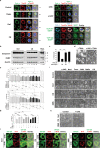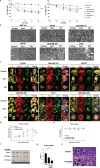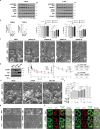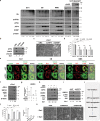Akt enhances the vulnerability of cancer cells to VCP/p97 inhibition-mediated paraptosis
- PMID: 38218922
- PMCID: PMC10787777
- DOI: 10.1038/s41419-024-06434-x
Akt enhances the vulnerability of cancer cells to VCP/p97 inhibition-mediated paraptosis
Abstract
Valosin-containing protein (VCP)/p97, an AAA+ ATPase critical for maintaining proteostasis, emerges as a promising target for cancer therapy. This study reveals that targeting VCP selectively eliminates breast cancer cells while sparing non-transformed cells by inducing paraptosis, a non-apoptotic cell death mechanism characterized by endoplasmic reticulum and mitochondria dilation. Intriguingly, oncogenic HRas sensitizes non-transformed cells to VCP inhibition-mediated paraptosis. The susceptibility of cancer cells to VCP inhibition is attributed to the non-attenuation and recovery of protein synthesis under proteotoxic stress. Mechanistically, mTORC2/Akt activation and eIF3d-dependent translation contribute to translational rebound and amplification of proteotoxic stress. Furthermore, the ATF4/DDIT4 axis augments VCP inhibition-mediated paraptosis by activating Akt. Given that hyperactive Akt counteracts chemotherapeutic-induced apoptosis, VCP inhibition presents a promising therapeutic avenue to exploit Akt-associated vulnerabilities in cancer cells by triggering paraptosis while safeguarding normal cells.
© 2024. The Author(s).
Conflict of interest statement
The authors declare no competing interest.
Figures








Similar articles
-
Valosin-Containing Protein (VCP)/p97: A Prognostic Biomarker and Therapeutic Target in Cancer.Int J Mol Sci. 2021 Sep 21;22(18):10177. doi: 10.3390/ijms221810177. Int J Mol Sci. 2021. PMID: 34576340 Free PMC article. Review.
-
AAA ATPase p97/valosin-containing protein interacts with gp78, a ubiquitin ligase for endoplasmic reticulum-associated degradation.J Biol Chem. 2004 Oct 29;279(44):45676-84. doi: 10.1074/jbc.M409034200. Epub 2004 Aug 24. J Biol Chem. 2004. PMID: 15331598
-
Interaction between salt-inducible kinase 2 (SIK2) and p97/valosin-containing protein (VCP) regulates endoplasmic reticulum (ER)-associated protein degradation in mammalian cells.J Biol Chem. 2013 Nov 22;288(47):33861-33872. doi: 10.1074/jbc.M113.492199. Epub 2013 Oct 15. J Biol Chem. 2013. PMID: 24129571 Free PMC article.
-
VCP/p97/Cdc48, A Linking of Protein Homeostasis and Cancer Therapy.Curr Mol Med. 2017;17(9):608-618. doi: 10.2174/1566524018666180308111238. Curr Mol Med. 2017. PMID: 29521227 Review.
-
Functional ATPase activity of p97/valosin-containing protein (VCP) is required for the quality control of endoplasmic reticulum in neuronally differentiated mammalian PC12 cells.J Biol Chem. 2002 Dec 6;277(49):47358-65. doi: 10.1074/jbc.M207783200. Epub 2002 Sep 25. J Biol Chem. 2002. PMID: 12351637
Cited by
-
Nigericin Induces Paraptosis-Like Cell Death Instead of Pyroptosis in Corneal Keratocytes.FASEB J. 2025 Jun 30;39(12):e70740. doi: 10.1096/fj.202500502R. FASEB J. 2025. PMID: 40540302 Free PMC article.
-
Natural products-induced cancer cell paraptosis.Food Sci Nutr. 2024 Sep 12;12(11):9866-9871. doi: 10.1002/fsn3.4461. eCollection 2024 Nov. Food Sci Nutr. 2024. PMID: 39619980 Free PMC article.
-
Exploring paraptosis as a therapeutic approach in cancer treatment.J Biomed Sci. 2024 Nov 4;31(1):101. doi: 10.1186/s12929-024-01089-4. J Biomed Sci. 2024. PMID: 39497143 Free PMC article. Review.
-
Dysregulated ribosome quality control in human diseases.FEBS J. 2025 Mar;292(5):936-959. doi: 10.1111/febs.17217. Epub 2024 Jul 1. FEBS J. 2025. PMID: 38949989 Free PMC article. Review.
-
SHP2-mediated ROS activation induces chondrocyte paraptosis in osteoarthritis and is attenuated by low-intensity pulsed ultrasound.J Orthop Translat. 2025 Apr 25;52:233-248. doi: 10.1016/j.jot.2025.04.005. eCollection 2025 May. J Orthop Translat. 2025. PMID: 40337549 Free PMC article.
References
Publication types
MeSH terms
Substances
LinkOut - more resources
Full Text Sources
Medical
Research Materials
Miscellaneous

